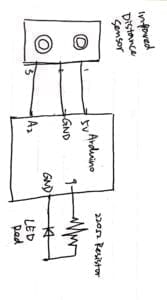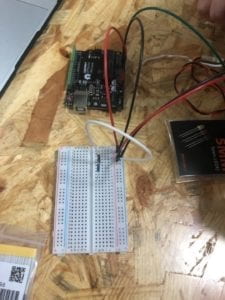Circuit 1
Components: 1* infrared distance sensor
1* LED
1* 220-ohm resistor
1* breadboard
1* Arduino
1 * USB A to B cable
A handful of jumper cables
Diagram:
Process: 1. Connect the Arduino with USB. 2. Choose the suitable sensor. 3. Design the circuit. 4. Connect the circuit according to the diagram. 5. Write the Arduino programming. 6. Test the circuit.
Problems encountered: we were confused about the code on the webpage which introduce how to translate the distance into digital signals. We reached an assistant for help and he explained how the code worked and taught us how to use map(). He also checked our circuit, finding out some incorrect connection. We then tried a few more times ourselves and soon we were able to get the sensor work.
Picture:
Video:
Circuit 2
Components: same
Diagram: same
Process: we made a few adjustments to our Arduino code, trying to make the LED go off when the distance between Arduino and sensor exceed 30cm.
Problems encountered: we struggled a bit when writing the “if…else…” code, but eventually successfully worked that out without external help. However, we then found that when we move our hand away from the sensor, it would go off for a second, then somehow it gave light again.
We failed to figure it out ourselves so we reached Young for help. He checked the sensor and our circuit and it turns out we set the ceiling number at 30, which the sensor could not sense. That makes the input be seen as a blank, thus, the LED would give light again. We changed the number to 20 and it worked perfectly.
Video:
Question 1: I intended to create a circuit that if the sensor senses the infrared ray, the LED would give light. It could be used to remind people of potential danger, for instance, the circuit could be built in the high voltage box, then if someone approaches and the distance could cause danger, the caution light would shine brightly to warn people. Also, it could be used for automatic lighting device so that if someone enter the area, it would give light, saving the trouble from groping in the dark to try to find the button, also save the energy by turning off the light if no one is in the room.
Question 2: Because for a certain programming software, the language is fixed. The final product of programming is the mixture and flexible application of the standard codes. People can do almost everything they want if they follow the instruction and make good use of the codes, which is similar to recipe or tutorial: do as you are told, and you will get what it should be. Also, you can make a little bit change to the order and other things to the code to create new patterns and make it more suitable to your purpose just like different chefs do to make their cuisines more delicious and unique.
Question 3: From my perspective, I think the most significant and remarkable influence that computer has on human is that it changes our thinking method and our behavior, including emotional feelings on technology. It regulates the idea of “change” and “new”, also updates our interpretation and perception of “precise” and “time”, as well as our concept of the combination of “simpleness” and “complexity”. It brings us to the new era of everything updating and renewing all the time. Moreover, it gives us a way to interact more with a certain machine, not only follows its working routine, but create something new. From this point of view, it also improve human’s creativity, even provide a new dimension of space for being creative.